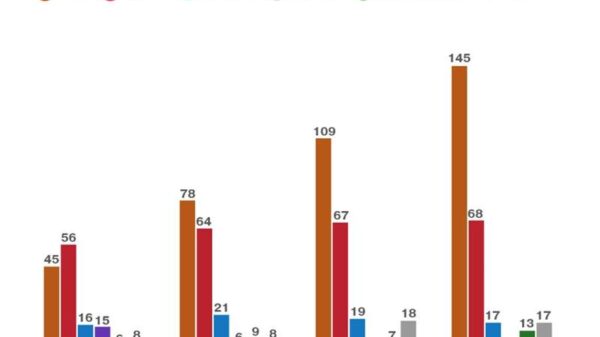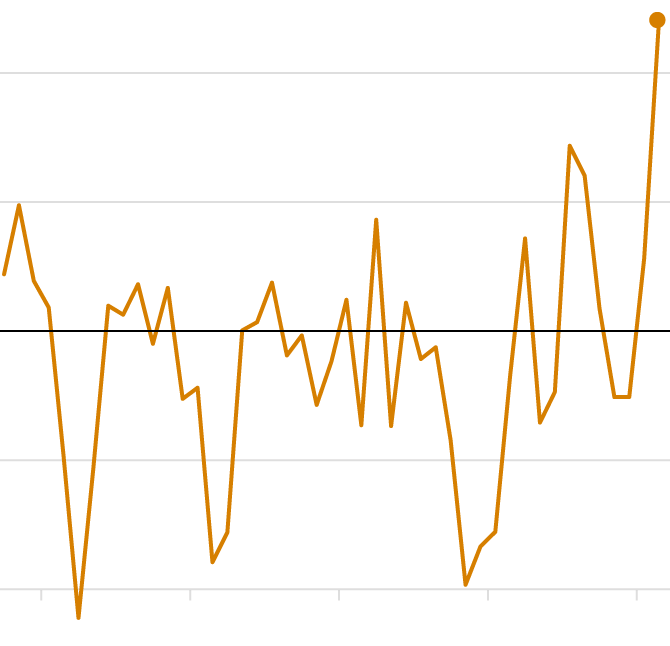Traffic deaths are surging during the pandemic.
The United States is enduring its most severe increase in traffic deaths since the 1940s.
It is a sharp change from the recent norm, too. Deaths from vehicle crashes have generally been falling since the late 1960s, thanks to vehicle improvements, lower speed limits and declines in drunken driving, among other factors. By 2019, the annual death rate from crashes was near its lowest level since cars became a mass item in the 1920s.
But then came the Covid-19 pandemic.
Crashes — and deaths — began surging in the summer of 2020, surprising traffic experts who had hoped that relatively empty roads would cause accidents to decline. Instead, an increase in aggressive driving more than made up for the decline in driving. And crashes continued to increase when people returned to the roads, later in the pandemic.
Per capita vehicle deaths rose 17.5 percent from the summer of 2019 to last summer, according to a Times analysis of federal data. It is the largest two-year increase since just after World War II.
U.S. traffic deaths per capita
Annual percent change ending in September of each year
This grim trend is another way that two years of isolation and disruption have damaged life, as this story — by my colleague Simon Romero, who’s a national correspondent — explains. People are frustrated and angry, and those feelings are fueling increases in violent crime, customer abuse of workers, student misbehavior in school and vehicle crashes.
‘Erratic behavior’
In his story, Simon profiles one of the victims, a 7-year-old boy in Albuquerque named Pronoy Bhattacharya. Like Pronoy, many other victims of vehicles crashes are young and healthy and would have had decades of life ahead of them if only they had not been at the wrong place at the wrong time.
Pronoy was killed as he crossed the street with his family in December, after visiting a holiday lights display. The driver had run a red light.
“We’re seeing erratic behavior in the way people are acting and their patience levels,” Albuquerque’s police chief, Harold Medina, told Simon. “Everybody’s been pushed. This is one of the most stressful times in memory.”
Art Markman, a cognitive scientist at the University of Texas at Austin, said that the emotions partly reflected “two years of having to stop ourselves from doing things that we’d like to do.” He added: “When you get angry in the car, it generates energy — and how do you dissipate that energy? Well, one way is to put your foot down a little bit more on the accelerator.”
Rising drug abuse during the pandemic seems to play an important role, as well. The U.S. Department of Transportation has reported that “the proportion of drivers testing positive for opioids nearly doubled after mid-March 2020, compared to the previous 6 months, while marijuana prevalence increased by about 50 percent.” (Mid-March 2020 is when major Covid mitigations began.)
Other factors besides the pandemic also affect traffic deaths, of course. But those other factors tend to change slowly — and often counteract each other. Improving technology and safety features reduce traffic deaths, while the growing size of vehicles and the rise of distracted driving lead to more deaths. The only plausible explanation for most of the recent surge is the pandemic.
Rising inequality
Vehicle crashes might seem like an equal-opportunity public health problem, spanning racial and economic groups. Americans use the same highways, after all, and everybody is vulnerable to serious accidents. But they are not equally vulnerable.
Traffic fatalities are much more common in low-income neighborhoods and among Native and Black Americans, government data shows. Fatalities are less common among Asian Americans. (The evidence about Latinos is mixed.) There are multiple reasons, including socioeconomic differences in vehicle quality, road conditions, substance abuse and availability of crosswalks.
These patterns mean that the rise in vehicle crashes over the past two years has widened racial and class disparities in health. In 2020, overall U.S. traffic deaths rose 7.2 percent. Among Black Americans, the increase was 23 percent.
One factor: Essential workers, who could not stay home and work remotely, are disproportionately Black, Destiny Thomas, an urban planner, told ABC News.
Another factor: Pedestrians are disproportionately Black, Norman Garrick of the University of Connecticut noted. “This is not by choice,” Garrick told NBC News. “In many cases, Black folks cannot afford motor vehicles.” As Simon’s story notes, recent increases in pedestrian deaths have been especially sharp.
The increasing inequality of traffic deaths is also part of a larger Covid pattern in the U.S.: Much of the burden from the pandemic’s disruptions has fallen on historically disadvantaged groups. (Deaths from Covid itself have also been somewhat higher among people of color.)
Learning losses have been largest for Black and Latino children, as well as children who attend high-poverty schools. Drug overdoses have soared, and they are heavily concentrated among working-class and poor Americans.
As I’ve written before, there are few easy answers on Covid. Continuing the behavior restrictions and disruptions of the past two years does have potential benefits: It can reduce the spread of the virus. But those same restrictions and disruptions have large downsides.
Many workplaces remain closed. Schools aren’t operating close to normally (as my colleague Erica Green has described). Millions of adults and children must wear masks all day long. These changes have created widespread frustration and anxiety — and the burdens of them do not fall equally across society.
Dr. David Spiegel, who runs Stanford Medical School’s Center on Stress and Health, has a clarifying way of describing the problem. People are coping with what he calls “social disengagement.” — a lack of contact with other people that in normal times provides pleasure, support and comfort. Instead, Spiegel said, “There’s the feeling that the rules are suspended and all bets are off.”
Programming note: We heard that yesterday’s newsletter — about ways to protect people vulnerable to Covid — went into some readers’ spam folders. You can read it here.
THE LATEST NEWS
Ukraine-Russia
-
Russia said it would pull back some troops from around Ukraine, a potential sign of de-escalation. Other military drills are continuing.
-
Yesterday, Russia’s top diplomat said more talks could resolve the country’s standoff with the West.
-
The Times’s Michael Schwirtz traveled along the Dnieper River to find out what it means to be Ukrainian right now.
-
And this video shows the scale of Russia’s military buildup.
The Virus
-
Prime Minister Justin Trudeau of Canada gave himself sweeping powers to respond to pandemic protests. (Some Canadians are baffled by the chaos.)
-
New York City fired 1,430 employees — less than 1 percent of its work force — for not complying with its vaccine mandate.
-
Sweden recommended that people 80 and over receive a second booster shot.
The Olympics
-
Olympic officials will withhold medals in events where Kamila Valieva, the Russian skater who failed a drug test, places in the top three.
-
Eileen Gu, competing for China, won silver in freeski slopestyle. The Swiss Mathilde Gremaud won gold.
-
Corinne Suter of Switzerland won the women’s downhill, with Mikaela Shiffrin of the U.S. finishing 18th.
Other Big Stories
-
The southwestern U.S. has been in a drought since 2000. It’s the region’s driest period in at least 1,200 years.
-
Donald Trump’s longtime accounting firm cut ties with his family business and retracted years of financial statements.
-
A judge plans to dismiss Sarah Palin’s lawsuit against The Times, saying her case failed to meet the legal standard of libel.
-
Nicaragua took control of five private universities, another sign that its president is inching toward an autocracy.
-
The killing of Christina Yuna Lee in her Manhattan apartment is part of an unsettling trend: a seemingly unprovoked attack in which the person charged is a homeless man.
Opinions
A stroke blurred Frank Bruni’s vision. It also helped him see other people’s struggles more clearly.
Lobster, once despised, is now a delicacy. The same could happen with insects, this video argues.
Efforts to ban books are frightening. But they have a thrilling subtext: Books are still powerful, The Washington Post’s Kate Cohen writes.
MORNING READS
Travel: The theme for 2022 is “go big.”
Fake heiress: Anna Sorokin (you may remember her as Anna Delvey) is back in the spotlight.
Ask an ethicist: A couple wonders about firing their unvaccinated babysitter.
“Zen mayor”: A Times reporter meditated with Eric Adams.
Advice from Wirecutter: A good stool can anchor your home.
Lives Lived: Rabbi Simcha Krauss led a rabbinical court that helped Orthodox women obtain Jewish divorces from recalcitrant husbands. He died at 84.
ARTS AND IDEAS
Cellular meat, anyone?
What does lab-grown sautéed chicken breast taste like?
The Times’s Kim Severson visited Upside Foods in the Bay Area, which is growing chicken from animal stem cells. The meat, she writes, “had less chew but much more flavor than a typical grocery-store breast.”
Supporters say cell-based meat — which is different from the plant-based meat sold by Beyond Meat, Impossible Burger and other companies — could lessen the environmental impact of industrial meat production and reduce animal suffering. Meat giants, government agencies and investors like Bill Gates see cell-based meat as a way to expand alternative meat. Critics caution that the environmental benefits are unproven, and that the scientific process to create the meat could introduce allergens.
Either way, engineered chicken is a long way from hitting the grocery store: Only a few hundred people in the world have purchased cellular meat, all of them in Singapore, the first nation to approve it.
PLAY, WATCH, EAT
What to Cook
A glossy brown sugar meringue crowns this blood orange pie.
What to Watch
High school is hard enough without a zombie outbreak: “All of Us Are Dead” is Netflix’s latest global hit.
World Through a Lens
A nomadic community in northern India has for centuries raised yaks and goats in scenic high plains.
Late Night
The hosts commented on Valentine’s Day.
Now Time to Play
The pangrams from yesterday’s Spelling Bee were valentine and ventilate. Here is today’s puzzle — or you can play online.
Here’s today’s Mini Crossword, and a clue: Rapper Shakur (five letters).
If you’re in the mood to play more, find all our games here.
Thanks for spending part of your morning with The Times. See you tomorrow. — David
P.S. Maya King is joining The Times from Politico to cover politics in the Southeast.
Here’s today’s front page.
“The Daily” is about Ukraine. On “The Ezra Klein Show,” Janet Lansbury discusses relationships.
Claire Moses, Ian Prasad Philbrick, Tom Wright-Piersanti, Ashley Wu and Sanam Yar contributed to The Morning. You can reach the team at themorning@nytimes.com.




























